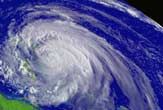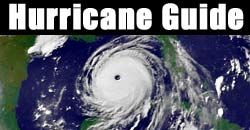Trees Hold Record of Ancient Hurricane Activity

Georgia pine trees harbor a record of every hurricane to hit the area in the past century, a new study found.
Further research across the Southeast uncovered a hurricane record stretching back more than two centuries. Even a storm from 1780 was revealed in the wood.
Researchers hope to apply their arboreal archeology to a broader geographic region, and to older trees, to investigate storm frequency over the past 550 years.
Since reliable accounts of historical hurricanes extend back only a century or so, the new technique could be a boon to climate researchers who wonder if global warming is altering the frequency of deadly tropical storms.
Link to global warming?
Recently, another scientist determined that global warming has enhanced the intensity of hurricanes. Other research has suggested that storm frequency could increase.
But hurricane activity can vary greatly from year-to-year, so short-term analysis generally says nothing about long-term trends. Further, slow-changing global oceanic and atmospheric cycles that last a decade or more bring long busy stretches and similarly lengthy dry spells. We are currently in a very busy stretch, and last week forecasters boosted their prediction for this season's hurricane total.
Sign up for the Live Science daily newsletter now
Get the world’s most fascinating discoveries delivered straight to your inbox.
To figure out if there is a longer trend toward more activity or not, researchers need a longer record.
Scientists have long known that tree rings are annual chapters in the book of climatology. The width and density of rings reveal warm versus dry years. Chemicals in the rings can even tell of forest fires and other atmospheric variations. Researchers have even found gold in tree rings, which they suspect is linked to volcanic activity.
But it's another matter to detect evidence for individual storms locked inside tree trunks.
In the new study, researchers examined growth rings in pine trees near Valdosta, Georgia, finding hurricane signatures that matched known storms.
"We've taken it back 100 years and didn't miss a storm," said Claudia Mora of the University of Tennessee.
Natural wayback machines
Mora's team then applied the technique to trees in other parts of the Southeast and uncovered a vault of hurricane information going back 227 years. Active periods were noted in the 1870s and 1950s, corresponding to spikes known from historical records.
Additional work revealed droughts and wet years in trees going back to 1450. One storm, known as the Great Hurricane of 1780, put its John Hancock in the trees.
The trees say hurricane activity from 1580–1640 was low, which matches with what scientists expect based on other clues to the climate from that time.
"What we're trying to do is understand frequency of hurricanes and how variable their occurrence is over the long-term," Mora said. "We're trying to come up with a reliable way to establish this."
Mora's team examined early-year and late-year growth. Most hurricanes strike late in the year, with August and September being the busiest months. They probed woody tissues for sudden drops in a particular oxygen isotope called oxygen-18.
Hurricane depletes the air of oxygen-18, so a hurricane's rain has less of it than other downpours. A shallow-rooted tree like the longleaf pine draws from a storm's rain within a couple weeks, leaving a storm's calling card in the new tissue.
Mora will present the results Thursday at a meeting co-convened by the Geological Society of America and Geological Association of Canada.
- 2005 Hurricane Guide
- Hurricane's Waves Soared to Nearly 100 Feet
- Forecast Boosted: Expect 7-9 More Hurricanes
- Gold in Them Thar Rings

Deadliest, costliest, busiest months, worst states, plus this year's storm names
The science of monster storms.
Forecast Boosted: Expect 7-9 More Hurricanes
Well into a busy season, forecasters say it'll be busier.

Image Gallery
Robert is an independent health and science journalist and writer based in Phoenix, Arizona. He is a former editor-in-chief of Live Science with over 20 years of experience as a reporter and editor. He has worked on websites such as Space.com and Tom's Guide, and is a contributor on Medium, covering how we age and how to optimize the mind and body through time. He has a journalism degree from Humboldt State University in California.
Most Popular


